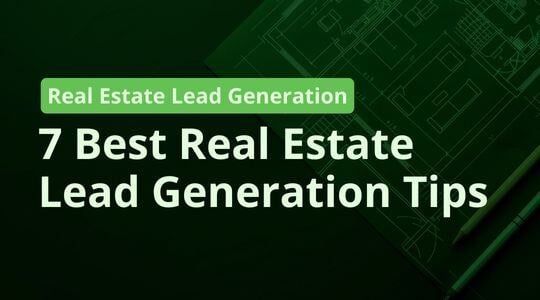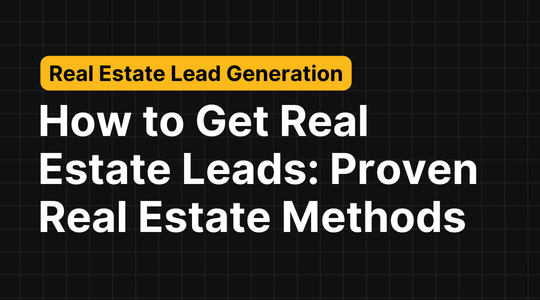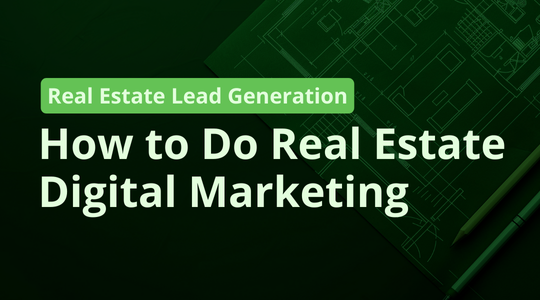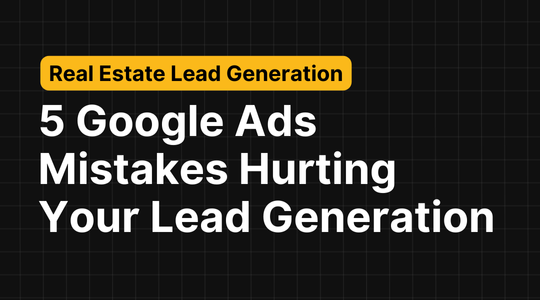There are many avenues in which a potential lead can find you—by clicking a Google Ad or Facebook Ad, watching a video on your YouTube channel or via an Instagram post. However a person stumbles upon your real estate business, you must direct them to a landing page. These pages are designed to convert a user into a lead.
Let’s explore real estate landing pages, so you understand why one must be part of your marketing strategy for real estate lead generation.
What Is a Real Estate Landing Page?
Landing pages are standalone web pages that users visit after clicking on an ad or call-to-action (CTA) on some part of your online presence (newsletter, website, social media post or bio, etc…)
Think of a landing page as the final destination for people interested in your real estate services. They are vital for real estate lead generation, ensuring your ad dollars aren’t wasted.

What is the Purpose of a Landing page?
Landing pages have two purposes:
- To further educate users about you and your company after they were initially intrigued by something they saw or read about you.
- To turn a user into a lead by clicking on one strategic CTA such as “book a call” or “subscribe to our newsletter”.
That’s it. Landing pages aren’t web pages with tons of copy and multiple messages and offerings.
It needs to be simple, compelling and straightforward.
What Is the Benefit of a Landing Page?
The benefit of a real estate landing page is simple. When properly executed, it can convert more traffic than a traditional website.
You must have the right elements in place for a landing page to convert. A bad landing page will lose users who could have easily become real estate leads, some ready to do business with you and others worth nurturing.
Landing Page vs. Homepage: What Is the Difference?
Some real estate agents confuse a homepage with a landing page but there are distinct differences.
Landing page vs. homepage:
|
Homepage |
Landing Page |
|
A homepage has many purposes such as communicating different products and/or services and aspects of your company. |
A landing page has one goal in mind. For instance, a landing page can solely exist to build a newsletter subscribers list or showcase one listing. It should never do both. |
|
A homepage can have multiple CTAs |
A landing page should have one CTA, even if it appears several times. Check out the Agent Launch Community landing page as an example. |
|
A homepage is a hub to direct visitors to relevant web pages and may contain many links. |
A landing page is a final destination that should not contain links outside the CTAs that correlate to a specific action. |
Here’s a strong example of a landing page for LinkedIn:

Here’s the homepage for Pixelgrade. Can you spot the difference between it and the LinkedIn landing page?
 Pixelgrade's homepage is clean and easy to read, but there's a top menu and several actions a user can take. It is trying to achieve many goals as a homepage should. The LinkedIn landing page is simple and offers two options for the same action to sign up for a free trial.
Pixelgrade's homepage is clean and easy to read, but there's a top menu and several actions a user can take. It is trying to achieve many goals as a homepage should. The LinkedIn landing page is simple and offers two options for the same action to sign up for a free trial.
Types of Real Estate Landing Pages
There are many types of real estate landing pages but some of the more popular ones include:
- A lead-generation landing page, also called a lead capture page, is designed to generate leads by collecting info. This info lets you contact the user for an initial conversation or meeting.
- A long-form landing page is longer than the typical landing page. It provides a lot of valuable content and information. These are ideal for companies with products or services that require more selling or for SEO purposes.
- An event landing page is to promote events and should be for either RSVPing or buying tickets.
- A product landing page highlights a product and should provide information about its benefits, features and value.
- A thank you landing page appears after a user purchases a product or fills out a form. You can communicate the next steps or treat it as the first stage of nurturing a lead.
Real estate agents should focus on lead-generation landing pages. The strategy is for your ads and social media activity to drive traffic to one landing page where you will capture the data you need (location, email, phone number, etc.) to turn them into a lead.
TIPS FOR TOP REAL ESTATE AGENTS: A landing page is a must for pay-per-click advertising. It will greatly contribute to your real estate lead generation. Also, Google weighs the quality of a pay-per-click ad based on the relevancy of its linked page.
5 Tips to Create Real Estate Landing Pages that Convert
Use these tips to build effective real estate landing pages that will consistently convert.
Tip #1: Know Your Audience
By first determining your target audience, you can design a landing page with them in mind. Consider what information they need, what pain point you’re solving and how much you can ask of them. By putting your audience first, you are more likely to get them to submit their contact information or take the next step.
Tip #2: Open With a Strong Headline
The headline in the hero banner on your landing page will be the first thing a visitor sees after clicking on an ad. It needs to be captivating and relevant.

If it doesn’t immediately strike a visitor, they will leave. If it doesn't match their intent, they will think they clicked on the wrong link.
Tip #3: Keep it Simple
Don’t overwhelm a landing page with copy and images. You only need what matters and can contribute to conversion. Messaging must be straightforward (no fancy marketing talk) and keep the amount of copy per section to a minimum.
Here is an example of how much copy is appropriate for a typical landing page section.

Remember, less is more.
Tip #4: Optimize for mobile
When we create landing pages, it is always on a desktop. More than half of internet traffic is from mobile devices, so your landing pages must be optimized for mobile.
Use responsive design, where a website adapts to a user’s device, or a mobile-first design.
Write concise copy that doesn’t force a mobile user to scroll for too long. Some suggestions are to use bullet points, only include the necessary copy, and keep paragraphs short.
Include a CTA above the fold right under the short opening copy that’s clear and sales-driven.
Tip #4: Build trust with social proof
You don’t have much time to build trust with a user in the hope of turning them into a lead. Social proof is evidence that other people have enjoyed doing business with you and have benefitted from it.
Include social proof in your landing page. This can be testimonials, client wins or data on your success, such as the number of houses sold.
FAQ
What is a real estate landing page?
A real estate landing page is a standalone web page that realtors can use for a single purpose like lead generation. A landing page should be linked to your Google Ads, Facebook Ads, in your social bios and wherever you are trying to generate real estate leads.
Do real estate agents need a landing page?
Any real estate agent doing online lead generation needs a landing page to convert users into leads and collect information for future outreach and lead nurturing.
What is the purpose of a landing page?
A landing page’s purpose is to compel a visitor to take a single action. The purpose depends on your goal: contact information capture, mailing list subscriptions, event RSVP, etc.
What are the different types of landing pages?
There are many types of landing pages. Some of the more common ones are lead generation, long-form, events, product launches or spotlights or to thank a user for completing an action.
What should I avoid including in a landing page?
Avoid multiple CTAs or conversion goals, too much or unnecessary copy, a navigation menu, not having messaging that reflects the ad copy and optimizing only for desktop.






















